
Lotus corniculatus is a flowering plant in the pea family Fabaceae, native to grasslands in temperate Eurasia and North Africa. Common names include common bird's-foot trefoil, eggs and bacon, birdsfoot deervetch, and just bird's-foot trefoil, though the latter name is often also applied to other members of the genus.
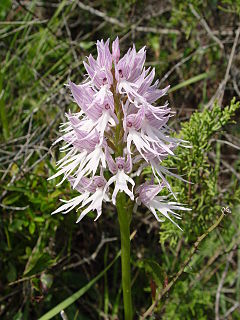
Orchis is a genus in the orchid family (Orchidaceae), occurring mainly in Europe and Northwest Africa, and ranging as far as Tibet, Mongolia, and Xinjiang. The name is from the Ancient Greek ὄρχις orchis, meaning "testicle", from the appearance of the paired subterranean tuberoids.
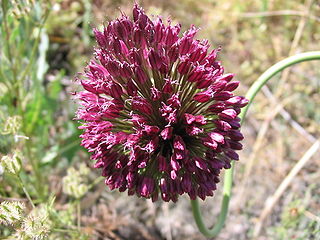
Allium sphaerocephalon is a plant species in the Amaryllis family known as round-headed leek and also round-headed garlic, ball-head onion, and other variations on these names. Other names include Drumsticks, and in Germany, Kugellauch. Some publications use the alternate spelling A. sphaerocephalum. It is a hardy perennial plant.
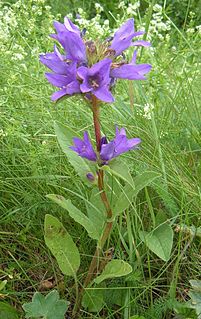
Campanula glomerata, known by the common names clustered bellflower or Dane's blood, is a species of flowering plant in the genus Campanula, belonging to the family Campanulaceae. It is the county flower of Rutland, England.

Anthemis arvensis, also known as corn chamomile, mayweed, scentless chamomile, or field chamomile is a species of flowering plant in the genus Anthemis, in the aster family. It is used as an ornamental plant.
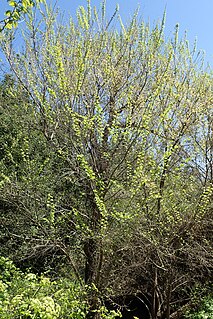
Ulmus minorsubsp.canescens is a small deciduous tree occasionally known by the common names grey elm, grey-leafed elm, and hoary elm. Its natural range extends through the lands of the central and eastern Mediterranean, from southern Italy, the islands of Sicily, Malta, Crete, Rhodes and Cyprus, to Turkey, and as far south as Israel, where it is now considered rare and endangered in the wild. The tree is typically found amidst the comparatively humid coastal woodlands and scrublands.

Coleus caninus, synonym Plectranthus caninus, is a herb from the mint family Lamiaceae, native to southern and eastern Africa from Angola to Sudan and to India and Myanmar.

Senecio vernalis is one of the European species of Senecio, an annual that is also known as eastern groundsel. While it has been long classified as Senecio vernalis, this species has more recently been described as a subspecies of Senecio leucanthemifolius and is now included by some in that species.

Acmispon dendroideus, synonym Syrmatium veatchii, is a species of legume native to California. It is known by the common name island broom. It is endemic to the Channel Islands of California, where it grows on coastal bluffs and cliffs. It is a spreading perennial herb or erect shrub approaching 2 meters in height. It is hairless to hairy and gray-green in color. The branches lined with leaves each made up of a few oval leaflike leaflets up to 1.5 centimeters long each. The inflorescence bears up to 10 yellow pealike flowers, each roughly a centimeter long and fading red as they age.

Hosackia gracilis, synonym Lotus formosissimus, is a species of legume native to western North America from British Columbia through Washington and Oregon to California. It was first described by George Bentham. It is known by the common name harlequin lotus. It grows in moist spots in the coastal mountains and down to the oceanside bluffs. It is a perennial herb growing upright or spreading to about 0.5 m in maximum length. It is lined with leaves each made up of a few oppositely arranged oval leaflets up to 2 cm long. The inflorescence is made up of several pealike flowers each 1 to 2 cm long. The flower has a bright yellow banner, or upper petal, and bright pink or white lower petals. The fruit is a legume pod 2 to 3 cm long.

Bembecia ichneumoniformis, the six-belted clearwing, is a moth of the family Sesiidae.

Aloiampelos ciliaris, formerly Aloe ciliaris, the common climbing-aloe, is a thin, tough, rapidly growing succulent plant from South Africa.

Lotus hirsutus, also known by the synonym Dorycnium hirsutum, common name: canary clover or hairy canary-clover, is a species of flowering plant in the legume family Fabaceae.

Lotus dorycnium, previously known by the synonym Dorycnium pentaphyllum, common names: prostrate Canary clover and badassi, is a herbaceous perennial plant belonging to the genus Lotus of the family Fabaceae.

Arabis caucasica is a species of flowering plant in the mustard family (Brassicaceae) known by the common names garden arabis, mountain rock cress or Caucasian rockcress. It is native to south eastern Europe and the Mediterranean. It is also present in the Madeira Archipelago.

Galanthus plicatus is a species of flowering plant in the family Amaryllidaceae, native from Romania, Ukraine and Crimea in eastern Europe to north Turkey and the north-west Caucasus in Asia.
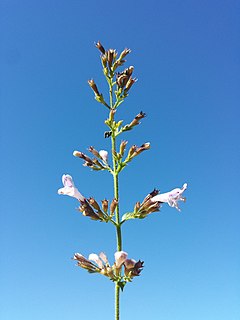
Clinopodium menthifolium, commonly known as the wood calamint or woodland calamint, is a species of flowering plant in the mint family, Lamiaceae. It is found throughout southern and central Europe from the United Kingdom and east as far as temperate parts of Asia, and as south as North Africa. It grows up to 1,700 m (5,600 ft) in elevation.
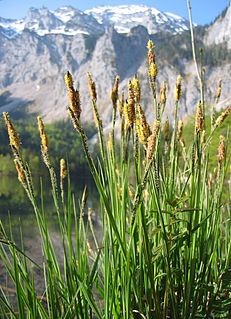
Carex elata, tufted sedge, is a species in the genus Carex, native to all of Europe, the Atlas Mountains of Africa, Turkey, Iran and Central Asia. It prefers to grow with its roots in water. Its cultivar 'Aurea' has gained the Royal Horticultural Society's Award of Garden Merit.

Genista sagittalis, called the arrow-jointed broom and winged broom, is a species of flowering plant in the genus Genista, native to central and southern Europe, Ukraine, and Anatolia. Its subspecies Genista sagittalis subsp. delphinensis, called rock broom, has gained the Royal Horticultural Society's Award of Garden Merit.

Juncus tenageia, called the sand rush, is a species of flowering plant in the genus Juncus, native to northwestern Africa, many of the Mediterranean islands, warmer parts of southern, central and eastern Europe, and western Asia including Turkey, the Caucasus region, and Kazakhstan. It is typically found growing in wet, nutrient-poor rock, sand or clay-based soils, often on the edges of roads, clay pits and old brickyards.




















